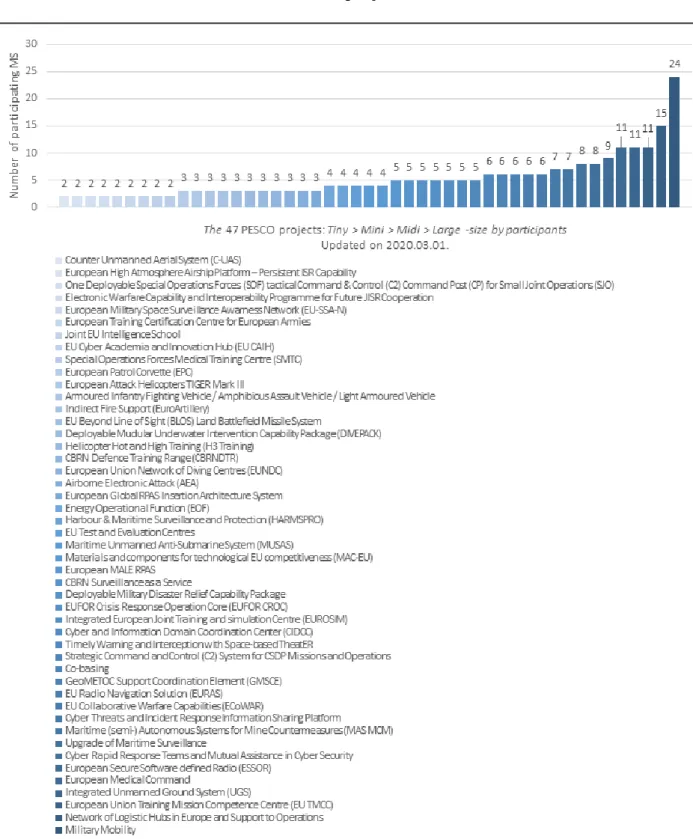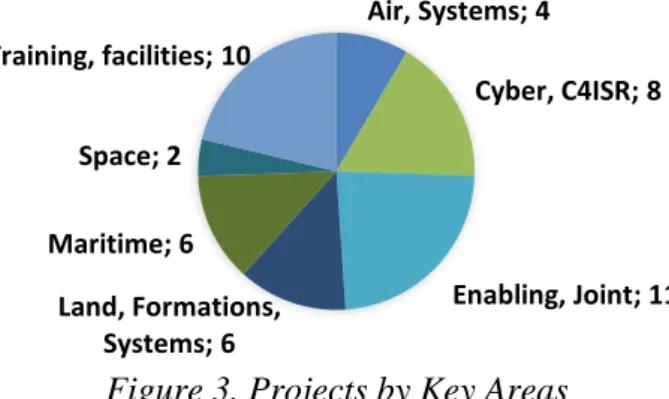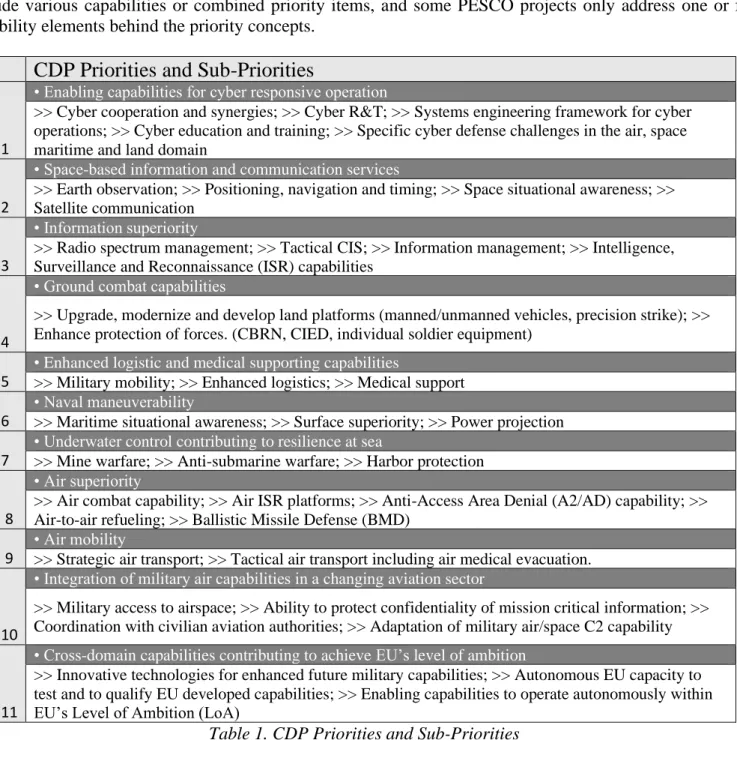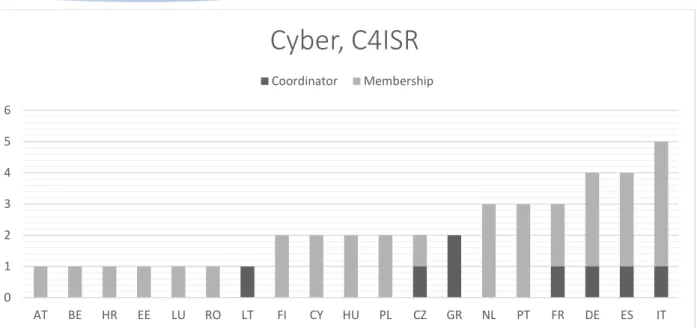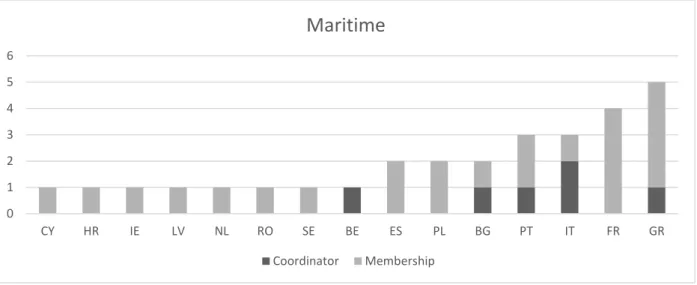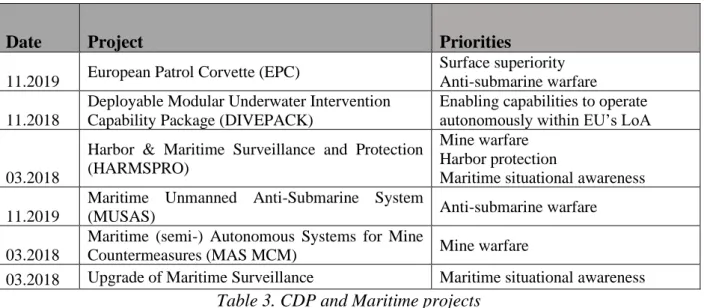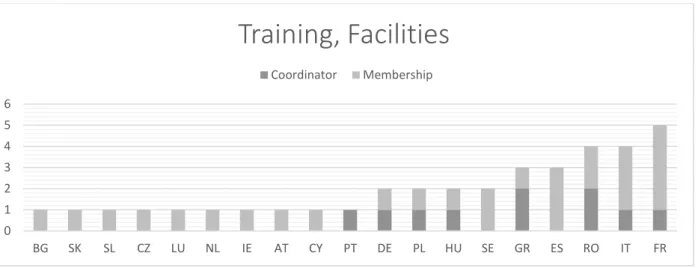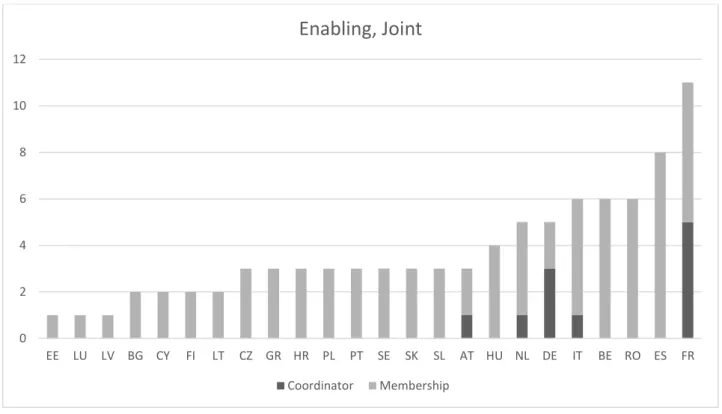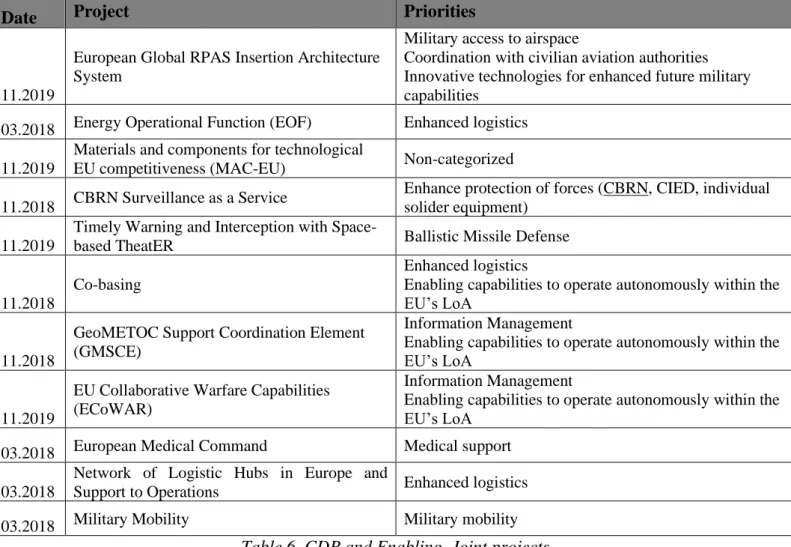Institute for Strategic and Defense Studies ISDS Analyses 2020/15.
23 04 2020
© Anna NÁDUDVARI – Alex ETL – Nikolett BERECZKY 1
Anna Nádudvari – Alex Etl – Nikolett Bereczky:
1Quo vadis, PESCO? An analysis of cooperative networks and capability development priorities
Introduction
According to the Lisbon Treaty’s provision, Permanent Structured Cooperation (PESCO) was established in 2017 with a set of binding commitments aiming to deepen defense cooperation among the 25 participating Member States (pMS) including almost all members except for Denmark, Malta and the United Kingdom.2 Participating Member States committed themselves to achieve a “coherent full spectrum force package” through five pillars of implementation.3 PESCO projects have received increased attention, as they are often portrayed
1 Anna Nádudvari (anna.nadudvari@uni-corvinus.hu) is a PhD candidate at the Corvinus University of Budapest. Alex Etl (etl.alex@uni-nke.hu) is an assistant research fellow at the Institute for Strategic and Defense Studies of Eötvös József Research Center at the National University of Public Service (Budapest, Hungary). Nikolett Bereczky (bereczky.nikolett@uni-nke.hu) is a PhD student at the National University of Public Service (Budapest, Hungary).
2 Notification on Permanent Structured Cooperation to the Council and to the High Representative of the Union for Foreign Affairs and Security Policy, [online], 2017. Source: consilium.europa.eu [31 03 2020]
3 (1) raise the level of investment expenditure on defense equipment to the 2007 collective benchmarks, (2) bring the defense apparatus into line with one another as far as possible, (3) enhance readiness, interoperability, and deployability of forces, (4) take the necessary measures to tackle the shortfalls perceived in the Capability Development Mechanism, and (5) take part in the development of major equipment programs through the EDA. See Annex II of Notification on Permanent Structured Cooperation to the Council and to the High Representative of the Union for Foreign Affairs and Security Policy, [online], 2017. Source: consilium.europa.eu [31 03 2020]
Executive Summary
• Out of the 47 running PESCO projects, only 1/5 have more than 7 members, while almost half of the projects have only 3 or less participants. Based on coordination and membership accounts, France (31) Italy (26) Spain (24) Germany (16), as the Big Four, are the most involved participating Member States. Subsequently, with regards to Member States’ involvement in capability areas, the Big Four’s involvement is the most diverse, while Poland, the Czech Republic, Netherlands, and Greece are also involved in at least 5 key project areas out of 7.
• Most PESCO projects contribute to general objectives of creating Enabling capabilities to operate autonomously within EU’s Level of Ambition (LoA), while high-end capability contributions are fewer, partly because PESCO projects contribute to Capability Development Priorities through complementing other activities and projects coordinated by EDA. Therefore, in some cases, the lack of PESCO projects aiming at these missing capability priorities can be explained by parallel EDA projects addressing those capability shortfalls.
• Member states are rather aligning their PESCO capability developments with the Big Four than with anyone else. This makes the overall PESCO network fundamentally centralized, in which everyone is tied to the core, while the relations among the peripheral nodes are rather limited.
• Central and Eastern European intra-regional PESCO relations are rather weak, since the participation in PESCO did not lead to the emergence of a strong and visible regional sub-cluster.
• Similarly, the V4 remains less visible within PESCO, suggesting that members of the group did not align their efforts in this field.
2
Institute for Strategic and Defense Studies ISDS Analyses 2020/15.
© Anna NÁDUDVARI – Alex ETL – Nikolett BERECZKY
as a forward-moving step with tangible prospects through the embodiment of deeper inter-state defense cooperation. There are 47 such projects so far, which had been adopted in three rounds: having the first 17 in March 2018, the second 17 in November 2018 and the third round of 13 projects in November 2019.4
Nevertheless, only a few studies have analyzed the added value of PESCO to European defense capabilities and its impact on the broader integration process so far. A policy brief by Efstathiou and Billon-Galland (2019) assessed whether the first two rounds of 34 projects had addressed the EU’s identified capability shortfalls by cross-referencing PESCO projects against the criteria of the EU’s 2018 revised Capability Development Priorities (CDP) and the EU’s Level of Ambition (LoA) requirements.5 A paper by Efstathiou, Hannigan and Béraud-Sudreau (2019) assessed progress on the implementation of the first two rounds of 34 projects.6 A CEPS research report by Blockmans and Crosson (2019) analyzed the degree of differentiation and convergence in Europe’s defense sector based on the three rounds of 47 PESCO projects in total.7 Building on the insights and methodologies applied in these previous reports, this paper aims to contribute to their findings by assessing the accounts of Member States’ involvement in the existing 47 PESCO projects while cross-referencing all 47 projects with the Capability Development Priorities and conducting a network analysis of participating Member States (pMS) in PESCO projects.
The paper is structured as follows: the first section introduces PESCO in the context of European defense cooperation. The second section turns towards the analysis of projects by the number of participating member states; looks at the involvement of participating member states by absolute numbers as well as their involvement in projects by areas, cross-referenced with Capability Development Priorities. The third section presents the network analysis of participating member states in PESCO projects. Besides the overall PESCO network it explores the emerging East-West imbalance within PESCO by analyzing the networks of various member states, including France, Spain, Italy, Germany and the Central and Eastern European countries with a special focus on the Visegrad Group.
Data on PESCO projects was accessed through the official PESCO projects website, data collection closing on March 4, 2020.8 In cross-referencing projects with CDP priorities we relied on the 2018 CDP revision of the EU Capability Development Priorities, issued by the European Defence Agency.9
PESCO projects and the broader context of European defense cooperation
PESCO projects are inevitably linked to the developments of a European defense industrial base through economies of scale (cross-border cooperation increasing division of labor and reducing duplications among national defense industrial bases) as well as through interoperability, which is a crucial aspect for strategic convergence.
Nevertheless, the ambitions of increasing defense integration through PESCO projects have been perceived either with a great deal of skepticism as yet another unsuccessful attempt at deepening European defense cooperation, or they have been welcomed with cautious cheers as a small but progressive step towards meeting more capability shortfalls of Europe. The functional–political concerns towards the implementation of PESCO had been displayed in the different visions of realizing its architecture mainly through the diverging approaches
4 Permanent Structured Cooperation (PESCO) updated list of PESCO projects - Overview, [online], 19 11 2018. Source:
consilium.europa.eu [31 03 2020]
5 Yvonni-Stefania EFSTATHIOU – Alice BILLION-GALLAND: Are PESCO projects fit for purpose? [online], 21 02 2019. Source:
iiss.org [30. 03. 2020]
6 Yvonni-Stefania EFSTATHIOU – Connor HANNIGAN – Lucie BÉRAUD-SUDREAU: Keeping the momentum in European defence collaboration: An early assessment of PESCO implementation, [online], 14 01 2019. Source: iiss.org [30 03 2020.]
7 Steven BLOCKMANS – Dylan MACCHIARINI CROSSON: Differentiated integration within PESCO – clusters and convergence in EU defence, [online], 2019. Source: ceps.eu [30 03 2020]
8 PESCO Member States Driven, [online], Source: pesco.europa.eu [30 03 2020]
9 2018 CDP revision – The EU Capability Development Priorities, [online], 2019, Source: eda.europa.eu [30 03 2020]
3
Institute for Strategic and Defense Studies ISDS Analyses 2020/15.
© Anna NÁDUDVARI – Alex ETL – Nikolett BERECZKY
of Germany and France. The achieved structure reflected Germany’s preference towards an inclusive form of enhanced cooperation with a high rate of Member State participation and numerous low-end capability projects, instead of a more ambitious and avant-garde formation of few capable and willing Member States with truly high-end capability projects. Although France promoted this latter (unrealized) concept, Paris took an active role in the implementation of this enlarged form of enhanced cooperation by the third round of adopting projects and took up coordination and participation of projects in the highest number among all EU members.
Efstathiou et al. (2019) argued that PESCO primarily serves as an extraneous and reassuring label and as a means to provide extra funding to existing programs, since these projects rely on funding from the European defense industrial development program (EDIDP) and its successor, the European Defense Fund (EDF). The quick multiplication of PESCO projects can result in competition between different projects and clusters of defense supply chains and it presents a dilemma for the attribution of funds: a choice between funding a small number of niche and large capability projects or fracturing funds amongst a large number of smaller projects due to political and diplomatic considerations.10 This already constrained setup have met with the uncertainties presented by the Multiannual Financial Framework negotiations for the EDF total sum – solving the attribution dilemma by splitting the baby half – leaving all potential recipients largely undercut.11 Uncertainties of the 2021-2027 MFF suggest that funding common defense capabilities remains subordinate to other more pressing priorities (especially amid the economic consequences of the COVID-19 crisis), which leaves the projects as a network of rather empty shells.
Therefore, the prospects of realizing PESCO projects to the extent that they would effectively contribute to priority capabilities for the EU’s Level of Ambition or in developing economies of scale are rather limited.
However, their significance is apparent in showing Member States’ preferences in creating cooperative links with other countries, reflecting the directions chosen in the future of interoperability and strategic convergence on a European scale. This is further strengthened by micro or soft foundations of interoperability such as engendering channels for cooperation, trust and information sharing, which are essential building blocks of strategic convergence. Thus, examining the constellation of EU Member States’ cooperation in PESCO can provide patterns of interstate cooperation that are susceptible to path-dependence not only in terms of economies of scale or cross-border supply chains but through the more subtle institutional channels serving convergence through dialogue. More importantly, such network analysis can reveal more about European defense clusters, and strategic decisions of individual pMS.
When interpreting the results of PESCO projects’ network analysis, it is important to keep in mind that any analysis of PESCO projects can be considered as only one segment of the various European interstate defense cooperation projects that are in effect today. Considering a comprehensive overview on the network of European defense cooperation, the network analysis on PESCO projects should be extended with other bi- and multilateral defense cooperation projects, which exist in various forms. This variety is apparent in projects on the bilateral level (e.g. British–French, Franco–German), some on the sub-regional (e.g. Benelux, Baltic, Nordic, Visegrad) and some on the broader EU (e.g. EU Battlegroups, EDA projects), and European (e.g. European Intervention Initiative) level. The intensity of these projects varies on a broad spectrum as well. Some of them cover operational cooperation, while others are focusing on pooling and sharing capabilities or co-development (such as capability projects coordinated by EDA).12 Similarly to other already existing forms of cooperation, PESCO projects show a mixed picture with regards to their intensity, which stretches from co-development to sharing
10 Yvonni-Stefania EFSTATHIOU – Connor HANNIGAN – Lucie BÉRAUD-SUDREAU: Keeping the momentum in European defence collaboration: An early assessment of PESCO implementation. 10.
11 Financial Framework (MFF) 2021-2027: Negotiating Box with figures, [online], 05 12 2019, Source: consilium.europa.eu [30 03 2020.]
12 Bence NÉMETH – Tamás CSIKI: Perspectives of Central European Multinational Defence Cooperation: A New
Model? In Marian Majer – Robert Ondrejcsák (Eds.), Panorama of Global Security Environment 2013. Bratislava: Centre for European and North Atlantic. Affairs. 11-24 and Jean Pierre MAULNY – Fabio LIBERTI: Pooling of EU Member States Assets in the Implementaion of ESDP, [online], 2008. Source: europarl.europa.eu [30 03 2020]
4
Institute for Strategic and Defense Studies ISDS Analyses 2020/15.
© Anna NÁDUDVARI – Alex ETL – Nikolett BERECZKY
best practices. Thus, the analysis of PESCO contributes to our partial understanding of European defense cooperation patterns, as well as to the preferences of certain groups of member states and individual countries.
Nevertheless, it can highlight the post-Brexit dynamics and directions of building defense cooperation across continental Europe.
Account of Member States’ involvement in PESCO projects
Figure 1. Project size by participating Member States (pMS)
5
Institute for Strategic and Defense Studies ISDS Analyses 2020/15.
© Anna NÁDUDVARI – Alex ETL – Nikolett BERECZKY
Projects’ size by number of participating member states (pMS)
By the third round of PESCO project adoption (12 November 2019) the 25 members have adopted 47 projects, which vary in their number of participating member states. While the smallest projects consist of only 2 members, the largest has 24 members. The number of member states in PESCO projects show a descending order, with fewer projects having more members. Based on membership count, most projects can be categorized as Tiny or Mini in their size: there are 20 Tiny (9 projects with participation of two and 11 projects with participation of three members); 17 Mini (with four to six members). Only the small fraction of eight projects amounts to be Midi with seven to eleven members, and there are just two Large projects with 15 and 24 members. Overall, only 1/5 of the projects involve more than 7 members. (See Figure 1.)
Project involvement of participating Member States (pMS): Coordination and Membership
Each project is carried forward by varying groups of PESCO participating Member States (Project Members) and is led by one or more PESCO participating Member States (Project Coordinator).
Figure 2. Member States’ involvement in PESCO projects13
The membership and coordination account of pMS can be cathegorized into five groups by size. Ireland (2) Luxemburg (3) the Baltic states (Estonia, Lithuania and Latvia) (3) and Slovenia (4) participate in a small number of projects, ranging from 2 to 4 projects, although Estonia and Lithuania each has a Coordinator position.
The second group with membership (including coordination) in 5 to 7 projects consists of Bulgaria (5) Finland (5) Austria (6) Croatia (6) Slovakia (6) and Sweden (7). This group is also diverse concerning the coordinator (BG, AT, SK, SE) and non-coordinator (SL, FI, HR) position of states.
The third group consists of pMS with membership (including coordination) in 9 to 10 projects, involving Belgium (9), Cyprus (9), the Czech Republic (9), Hungary (10) and Portugal (10). All pMS of this group has at least one coordinator position (Portugal has two).
The fourth group consists of states with membership (including coordination) in 11-16 projects: Poland (11), the Netherlands (11), Romania (12), Greece (15) and Germany (16). Member states with few coordination
13 All figures and tables in the analysis were prepared by the authors.
0 1 1 0 0 0 1 0 1 0 1 1 1 1 1 1 2 1 1 2 5 7
2
9 10
2 2 2 3 3 4 4 5 5 6 5 6 8 8 8 9 8 10 10 10
10 9 22 17
21
0 5 10 15 20 25 30 35
IE EE LT LU LV SL BG FI AT HR SK SE BE CY CZ HU PT PL NL RO GR DE ES IT FR Project Coordinator Project Member
6
Institute for Strategic and Defense Studies ISDS Analyses 2020/15.
© Anna NÁDUDVARI – Alex ETL – Nikolett BERECZKY
positions are Poland (1), the Netherlands (1) and Romania (2), while Greece (5) and Germany (7) are coordinators in a high number of projects.
The fifth group consists of Spain, Italy and France with membership (including coordination) in 24 to 31 projects. These basic metrics of the PESCO project membership and coordination data show that in terms of coordination and total membership count, France and Italy are the top ranking pMS, while Spain and Germany follow close behind. Although Spain participates in numerous projects, its coordination count (2) is the lowest among the top 5 most involved member states (FR, IT, ES, DE, GR). Even though Germany’s membership count is slightly ahead of Greece, its coordination of projects, which have higher number of participants qualifies it to the same league in terms of networks as Spain, Italy and France. Therefore, we refer to these four pMS in our analysis as the Big Four of EU defense cooperation (See Figure 11).
An alternative grouping by the level of coordination shows that while many smaller pMS are non- coordinators, most small and middle-size states aimed to coordinate at least one project – often the one towards which they had national capability requirements as well. Nevertheless, some pMS seem to punch above their weight at least relative to the majority of countries with only 1 or no coordinator position. Portugal and Romania with 2-2 and Greece with 5 projects are relevant here, even if their coordination is mostly constrained to Tiny projects involving only 2-3 pMS (e.g. Joint EU Spy School with Greece and Cyprus; EU Cyber Academia and Innovation Hub with Portugal and Spain; and EU Network of Diving Centers with Romania, Bulgaria and France), although Greece also coordinates two Midi projects (Cyber Threats and Incident Response Information Sharing Platform; Upgrade of Maritime Surveillance) with membership of 7 and 8 countries.
Member states of PESCO continue to sign up to existing projects. Following the third round (November 2019) of accepting PESCO projects, three countries have joined in late accession to already existing projects so far. Poland joined to the project of European Medical Command, France joined to the Upgrade of Maritime Surveillance project and Greece joined to the European Patrol Corvette project. We have included these late accessions in our dataset but note here that the membership base of current projects can further be broadened in the future.
PESCO projects by Key Areas and CDP priorities
PESCO’s three rounds consist of both operational and capability development projects. PESCO projects are officially categorized into seven key areas. These are Air, Systems; Cyber, C4ISR; Enabling, Joint; Land, Formations, Systems; Maritime; Space; Training, Facilities.14
Figure 3. Projects by Key Areas
In this section, we analyze the Project by Areas grouping. We look at countries’ participation in each project area category first, address rankings in coordination and membership numbers, as well as non-participation data,
14 PESCO Member States Driven, [online], Source: pesco.europa.eu [30. 03. 2020.]
Air, Systems; 4
Cyber, C4ISR; 8
Enabling, Joint; 11 Land, Formations,
Systems; 6 Maritime; 6
Space; 2 Training, facilities; 10
7
Institute for Strategic and Defense Studies ISDS Analyses 2020/15.
© Anna NÁDUDVARI – Alex ETL – Nikolett BERECZKY
map the positions of the “Big Four” and explore, which pMS have the most diverse participation account based on the official Projects by Areas classification. Extending this analysis, we look at projects in each area and cross-reference them with Capability Development Priorities, in order to assess which priorities are well covered or remain unaddressed by PESCO projects.
EU Capability Development Plan addresses 11 areas, consisting of altogether 38 priorities.15 These priorities include various capabilities or combined priority items, and some PESCO projects only address one or few capability elements behind the priority concepts.
CDP Priorities and Sub-Priorities
1
• Enabling capabilities for cyber responsive operation
>> Cyber cooperation and synergies; >> Cyber R&T; >> Systems engineering framework for cyber operations; >> Cyber education and training; >> Specific cyber defense challenges in the air, space maritime and land domain
2
• Space-based information and communication services
>> Earth observation; >> Positioning, navigation and timing; >> Space situational awareness; >>
Satellite communication
3
• Information superiority
>> Radio spectrum management; >> Tactical CIS; >> Information management; >> Intelligence, Surveillance and Reconnaissance (ISR) capabilities
4
• Ground combat capabilities
>> Upgrade, modernize and develop land platforms (manned/unmanned vehicles, precision strike); >>
Enhance protection of forces. (CBRN, CIED, individual soldier equipment) 5
• Enhanced logistic and medical supporting capabilities
>> Military mobility; >> Enhanced logistics; >> Medical support 6
• Naval maneuverability
>> Maritime situational awareness; >> Surface superiority; >> Power projection 7
• Underwater control contributing to resilience at sea
>> Mine warfare; >> Anti-submarine warfare; >> Harbor protection
8
• Air superiority
>> Air combat capability; >> Air ISR platforms; >> Anti-Access Area Denial (A2/AD) capability; >>
Air-to-air refueling; >> Ballistic Missile Defense (BMD) 9
• Air mobility
>> Strategic air transport; >> Tactical air transport including air medical evacuation.
10
• Integration of military air capabilities in a changing aviation sector
>> Military access to airspace; >> Ability to protect confidentiality of mission critical information; >>
Coordination with civilian aviation authorities; >> Adaptation of military air/space C2 capability
11
• Cross-domain capabilities contributing to achieve EU’s level of ambition
>> Innovative technologies for enhanced future military capabilities; >> Autonomous EU capacity to test and to qualify EU developed capabilities; >> Enabling capabilities to operate autonomously within EU’s Level of Ambition (LoA)
Table 1. CDP Priorities and Sub-Priorities
15 2018 CDP revision – The EU Capability Development Priorities.
8
Institute for Strategic and Defense Studies ISDS Analyses 2020/15.
© Anna NÁDUDVARI – Alex ETL – Nikolett BERECZKY
Figure 4. Member States’ involvement in Cyber, C4ISR projects
Within the Cyber, C4ISR area, Greece coordinates two projects, while members of the Big Four (FR, DE, ES, IT) coordinate one project each. Next to them, project leaders are Lithuania (1) and the Czech Republic (1).
Italy’s participation is the highest in Cyber, C4ISR projects, followed by Germany (4) and Spain (4), whereas France, the Netherlands and Portugal are participating in 3 projects each. Bulgaria, Ireland, Latvia, Sweden, Slovakia and Slovenia are not participating in Cyber, C4ISR projects.
Date Project Priorities
11.2018
European High Atmosphere Airship Platform – Persistent ISR Capability
ISR capabilities Air ISR platforms
11.2018
One Deployable Special Operations Forces (SOF) tactical Command & Control (C2) Command Post (CP) for Small Joint Operations (SJO)
Tactical CIS
Information Management
11.2018
Electronic Warfare Capability and Interoperability Program for Future JISR Cooperation
ISR capabilities
11.2019
Cyber and Information Domain Coordination
Center (CIDCC) Cyber cooperation and synergies
03.2018
Strategic Command and Control (C2) System for CSDP Missions and Operations
Information Management
Enabling capabilities to operate autonomously within EU’s LoA
03.2018
Cyber Threats and Incident Response Information Sharing Platform
Cyber cooperation and synergies Cyber R&T
03.2018
Cyber Rapid Response Teams and Mutual Assistance in Cyber Security
Cyber cooperation and synergies
Systems engineering frameworks for cyber operations
03.2018
European Secure Software defined Radio (ESSOR)
Tactical CIS
Radio spectrum management Table 2. CDP and Cyber, C4ISR projects
0 1 2 3 4 5 6
AT BE HR EE LU RO LT FI CY HU PL CZ GR NL PT FR DE ES IT
Cyber, C4ISR
Coordinator Membership
9
Institute for Strategic and Defense Studies ISDS Analyses 2020/15.
© Anna NÁDUDVARI – Alex ETL – Nikolett BERECZKY
Cross-referencing with the Capability Development priorities shows that projects in the Cyber, C4ISR area include priorities of Information superiority and Enabling capabilities for cyber responsive operations. Within the area of Information superiority, armed forces’ ability to use Radio Spectrum (RS) for military activities, interoperable tactical Communication and Information Systems (CIS), information management within EU-led missions and operations and Intelligence, Surveillance and Reconnaissance (ISR) networked capabilities are addressed by C4ISR projects. Three priorities are addressed by PESCO projects from Enabling capabilities for cyber responsive operations: 1) cyber cooperation and synergies with relevant actors across cyber defense and cybersecurity areas, at EU level but also in the EU/NATO framework; 2) systems engineering frameworks for cyber operations which can provide Member States’ forces with common vocabulary, technical, procedural and organizational guidance and standards from which interoperable cyber capabilities can then be developed and implemented are addressed by projects; 3) cyber defense research and technology activities aiming at defensive cyber technologies.
Figure 5. Member States’ involvement in Maritime projects
Within the Maritime area, Italy is the only country that coordinates at least two projects, while Belgium, Bulgaria, Greece and Portugal are leading one project each. Greece’s participation in Maritime projects is the highest of all pMS, with membership in 5 different projects. France participates is 4, Italy and Portugal in 3, while Bulgaria, Poland and Spain in 2 Maritime projects. Germany, Austria, the Czech Republic, Estonia, Finland, Hungary, Lithuania, Latvia, Slovakia and Slovenia are not participating in any Maritime projects. With the missing of Germany, this is the only case, when a Big Four member is not participating at all in a project area.
Cross-referencing with the 2018 Capability Development Priorities shows that projects in the Maritime area include priorities of Naval Maneuverability and Underwater control contributing to resilience at sea. According to the CDP, within the area of Naval Maneuverability, the priority of Surface superiority at sea covers interoperable capabilities in the domains of long endurance at sea (enabled by unmanned high-end platforms), modular-designed multipurpose combat ships and adaptable offshore patrol vessels. From these, one Maritime PESCO project address the capabilities of modular designed multipurpose combat ships (European Patrol Corvette). According to the CDP, the priority of Maritime situational awareness is supposed to be met by capabilities in the areas of recognized maritime picture, surveillance awareness, maritime patrol and surveillance aircraft, maritime signal intelligence, long-range coastal radar networks, tactical radar maritime surveillance generated by UAV and maritime C2 capabilities based on automatic data link systems and data fusion systems. Regarding these priorities, Maritime PESCO projects either integrate cross-domain surveillance
0 1 2 3 4 5 6
CY HR IE LV NL RO SE BE ES PL BG PT IT FR GR
Maritime
Coordinator Membership
10
Institute for Strategic and Defense Studies ISDS Analyses 2020/15.
© Anna NÁDUDVARI – Alex ETL – Nikolett BERECZKY
systems (using existing infrastructure, such as in Upgrade of Maritime Surveillance project) or aimed at the integration of Unmanned Underwater Vehicles (DIVEPACK). The priority of Power Projection is rather poorly addressed by Maritime projects since they do not cover long-range logistic support, nor naval aviation (including strike capability), although multidimensional protection of naval forces (anti-submarine assets) or support of power projection through surveillance capabilities can be related to this priority.
Date Project Priorities
11.2019 European Patrol Corvette (EPC) Surface superiority Anti-submarine warfare 11.2018
Deployable Modular Underwater Intervention Capability Package (DIVEPACK)
Enabling capabilities to operate autonomously within EU’s LoA
03.2018
Harbor & Maritime Surveillance and Protection (HARMSPRO)
Mine warfare Harbor protection
Maritime situational awareness 11.2019
Maritime Unmanned Anti-Submarine System
(MUSAS) Anti-submarine warfare
03.2018
Maritime (semi-) Autonomous Systems for Mine
Countermeasures (MAS MCM) Mine warfare
03.2018 Upgrade of Maritime Surveillance Maritime situational awareness Table 3. CDP and Maritime projects
According to the CDP, from the area of Underwater control contributing to resilience at sea, the priority of maritime countermine warfare relies on a European concept of operations, dedicated unmanned systems as well as military/countermine diving capabilities. The priority of anti-submarine capabilities covers water space management, unmanned and fixed detection systems, counter torpedo systems and a detection/response system by air assets, while the priority of harbor protection is based on permanent detection systems of harbor approaches from the sea and resilience of naval critical infrastructure. PESCO maritime projects address some aspects of these priorities, although they do not completely cover all their segments.
Figure 6. Member States’ involvement in Land, Formations, Systems projects
0 1 2 3 4 5
LV CZ AT HR NL PL FI EE GR HU BE CY SK DE ES FR IT
Land, Formations, Systems
Coordinator Membership
11
Institute for Strategic and Defense Studies ISDS Analyses 2020/15.
© Anna NÁDUDVARI – Alex ETL – Nikolett BERECZKY
Within the Land, Formations, Systems area Italy is the only country that coordinates at least two projects, while Italy is also the lead nation in terms of participation with membership in 4 different projects. Besides, France, Germany, Estonia and Slovakia are also project coordinators in the area. France and Spain are participating in 3 Land, formations, systems projects, though the latter does not coordinate any of them. They are followed by Greece, Hungary, Belgium, Cyprus, Slovakia and Germany with two project memberships.
Bulgaria, Ireland, Lithuania, Luxemburg, Portugal, Romania, Sweden, Slovenia are not participating in any Land, formations and systems projects.
Date Project Priorities
03.2018
Armored Infantry Fighting Vehicle / Amphibious Assault Vehicle / Light Armored Vehicle
Upgrade, modernize and develop land platforms (manned vehicles)
03.2018
Indirect Fire Support (EuroArtillery) Upgrade, modernize and develop land platforms (precision strike)
11.2018
EU Beyond Line of Sight (BLOS) Land Battlefield Missile System
Upgrade, modernize and develop land platforms (precision strike)
03.2018
Deployable Military Disaster Relief Capability Package
Enabling capabilities to operate autonomously within EU’s Level of Ambition
03.2018
EUFOR Crisis Response Operation Core (EUFOR CROC)
Enabling capabilities to operate autonomously within EU’s Level of Ambition
11.2018
Integrated Unmanned Ground System (UGS)
Upgrade, modernize and develop land platforms (unmanned vehicles) Table 4. CDP and Land, formations, systems projects
Cross-referencing Land, formations, systems projects with the 2018 Capability Development Priorities shows that they primarily address the priority to upgrade, modernize and develop land platforms within the area of Ground combat capabilities. This includes ground-based precision strike capabilities, as well as manned and unmanned vehicles, since PESCO projects address Infantry Fighting Vehicles, indirect fire support and anti- tank weapons (EuroArtillery, BLOS). Within the CDP area of Cross-border capabilities contributing to achieve EU’s level of ambition, Land, Formations and Systems projects also address enabling capabilities to operate autonomously within the EU’s LoA, which is in connection with EU CSDP Permanent Strategic, Military Strategic and Tactical Command and Control and Stabilization/Capacity building capabilities.
12
Institute for Strategic and Defense Studies ISDS Analyses 2020/15.
© Anna NÁDUDVARI – Alex ETL – Nikolett BERECZKY
Figure 7. Member States’ involvement in Training, Facilities projects
Greece and Romania coordinates the most Training and facilities projects (2-2 each). From the Big Four, France (1), Italy (1), Germany (1) are present among coordinatiors, while Hungary, Poland, and Protugal are also leading 1 project each. With regards to membership, France (5) has the highest participation score in Training, facilities projects, followed by Italy and Romania (4-4). Greece and Spain are participating in 3 projects, while Germany, Hungary, Poland and Sweden have 2-2 memberships. Belgium, Estonia, Finland, Croatia, Lithuania, Latvia are not participants in Training,facilities projects.
Date Project Priorities
03.2018
European Training Certification Centre for European Armies
Autonomous EU capacity to test and to qualify EU developed capabilities 11.2018 Joint EU Intelligence School Non-categorized
11.2019
EU Cyber Academia and Innovation Hub (EU
CAIH) Cyber education and training
11.2019
Special Operations Forces Medical Training Centre
(SMTC) Medical support
11.2018 Helicopter Hot and High Training (H3 Training) Enabling capabilities to operate [autonomously] with the EU’s LoA 11.2019 CBRN Defense Training Range (CBRNDTR) Enhance protection of forces (CBRN) 11.2019
European Union Network of Diving Centers (EUNDC)
Enabling capabilities to operate [autonomously] with the EU’s LoA*
11.2018 EU Test and Evaluation Centers Autonomous EU capacity to test and to qualify EU developed capabilities 11.2019
Integrated European Joint Training and Simulation Centre (EUROSIM)
Enabling capabilities to operate [autonomously] with the EU’s LoA*
03.2018
European Union Training Mission Competence Centre (EU TMCC)
Enabling capabilities to operate autonomously with the EU’s LoA*
Autonomous EU capacity to test and to qualify EU developed capabilities*
Table 5. CDP and Training, Facilities projects
0 1 2 3 4 5 6
BG SK SL CZ LU NL IE AT CY PT DE PL HU SE GR ES RO IT FR
Training, Facilities
Coordinator Membership
13
Institute for Strategic and Defense Studies ISDS Analyses 2020/15.
© Anna NÁDUDVARI – Alex ETL – Nikolett BERECZKY
Cross-referencing with the 2018 Capability Development Priorities shows that projects in the Training, Facilities area can be linked to various cross-domain priorities, and they mostly relate to operational capabilites.
Training, Facilities projects mainly address priorities of the Cross domain capabilities contribution to achieve the EU’s LoA area, primarily in Enabling capabilities to operate autonomously within the EU’s LoA as well Autonomous EU capacity to test and to qualify EU developed capabilities prior to deployment in operations and missions. Within the CDP area of Ground combat capabilities, priority of enhanced force protection is addressed in CBRN training, while the interoperability of Medical Support is addressed from the priorities of Enhanced Logistics and medical supporting capabilities. From the priorities of Enabling capabilities for cyber responsive operation, cyber education and training is addressed among Training, Facilities projects.
Figure 8. Member States’ involvement in Enabling, Joint projects
In the Enabling, Joint category, France coordinates 5, while Germany coordinates 3 projects. Besides them, Italy, the Netherlands and Austria are coordinating 1-1 project. The highest participation score in the Enabling, Joint category ultimately goes to France (11), followed by Spain (8), Romania (6), Italy (6) and Belgium (6).
The Netherlands and Germany are participating in 5-5, whereas Hungary in 4 different projects. Ireland is the only state that is not involved in any Enabling, joint projects, while Estonia, Luxemburg and Latvia are only involved in the 24-member strong Military Mobility project.
Similarly to the Training, Facilities area, projects in the Enabling, Joint category show a diverse picture when cross-referenced with 2018 Capability Development Priorities. While most projects contribute to priorities related to Enhanced logistic and medical supporting capabilities (Military Mobility, Medical Support, Enhanced Logistics), there are projects addressing Cross domain capabilities contributing to achieve EU’s level of ambition, such as the priorities of enabling capabilities to operate autonomously within the EU’s LoA or innovative technologies for enhanced future military capabilities.
0 2 4 6 8 10 12
EE LU LV BG CY FI LT CZ GR HR PL PT SE SK SL AT HU NL DE IT BE RO ES FR
Enabling, Joint
Coordinator Membership
14
Institute for Strategic and Defense Studies ISDS Analyses 2020/15.
© Anna NÁDUDVARI – Alex ETL – Nikolett BERECZKY
Date Project Priorities
11.2019
European Global RPAS Insertion Architecture System
Military access to airspace
Coordination with civilian aviation authorities Innovative technologies for enhanced future military capabilities
03.2018 Energy Operational Function (EOF) Enhanced logistics 11.2019
Materials and components for technological
EU competitiveness (MAC-EU) Non-categorized
11.2018 CBRN Surveillance as a Service Enhance protection of forces (CBRN, CIED, individual solider equipment)
11.2019
Timely Warning and Interception with Space-
based TheatER Ballistic Missile Defense
11.2018
Co-basing
Enhanced logistics
Enabling capabilities to operate autonomously within the EU’s LoA
11.2018
GeoMETOC Support Coordination Element (GMSCE)
Information Management
Enabling capabilities to operate autonomously within the EU’s LoA
11.2019
EU Collaborative Warfare Capabilities (ECoWAR)
Information Management
Enabling capabilities to operate autonomously within the EU’s LoA
03.2018 European Medical Command Medical support 03.2018
Network of Logistic Hubs in Europe and
Support to Operations Enhanced logistics
03.2018 Military Mobility Military mobility
Table 6. CDP and Enabling, Joint projects
According to the CDP, these innovative technologies cover a few key domains such as artificial intelligence (AI), unmanned systems, remotely-operated or autonomous medical systems, autonomous and automated guidance, navigation and control (GNC) and decision-making techniques for manned and unmanned systems, multi-robot control or advanced materials, processes and technologies. The project of European Global RPAS Insertion Architecture System only vaguely addresses these domains by the development of concepts, doctrines and standardization for Unmanned Aircraft System (UAS) and Counter-UAS use as well as basic and advanced training on selected RPAS. Thus, this project addresses priorities within the area of Integration of military air capabilities in a changing aviation sector, such as Military access to airspace and interoperability and coordination with civilian aviation structures, infrastructures and procedures while maintaining military-to- military interoperability. Enabling, Joint projects also include contributions to priorities of Information superiority (Information Management); Ground combat capabilities (Enhance protection of forces in CBRN) as well as Air superiority (Ballistic Missile Defence).
15
Institute for Strategic and Defense Studies ISDS Analyses 2020/15.
© Anna NÁDUDVARI – Alex ETL – Nikolett BERECZKY
The Air, Systems area shows the Big Four’s leadership dominance – with France leading 2, Italy, Germany, Spain leading 1-1 projects each. Besides these member states, the Czech Republic (2) and Sweden (1) are also participating in Air Systems projects.
The two projects in the Space filed show the leadership of France and Italy. The other two Big Four member states are also participating in 1-1 projects. Besides them, Poland and Belgium are involved in this area.
Date Project Priorities
11.2018 Counter Unmanned Aerial System (C-UAS) Anti-access area denial (A2AD) capabilities
11.2018 European Attack Helicopters TIGER Mark III Air combat capability 11.2019 Airborne Electronic Attack (AEA) Air combat capability
Power projection
11.2018 European MALE RPAS Air ISR platforms
Air combat capability Table 7. CDP and Air, Systems projects
Projects included in the Air, Systems area feature priorities of Air superiority. This includes the priority of Air combat capability addressed by projects aiming at attack helicopter fleets, airborne electronic attack capabilities and armed remotely piloted aircraft systems (RPAS). Furthermore, the MALE RPAS project also addresses the priority of Air ISR platforms. According to the CDP, anti-access – area denial capabilities are based on long-range radars, counter UAV and tactical anti-missile capabilities as well as short-range air defense systems. This latter priority is addressed by one project that aims at countering mini and micro Unmanned Aerial Systems (C-UAS).
Date Project Priorities
11.2018
European Military Space Surveillance Awareness
Network (EU-SSA-N) Space Situational Awareness
11.2018 EU Radio Navigation Solution (EURAS) Positioning, Navigation and Timing Table 8. CDP and Space projects
0 2 4
SE CZ IT DE ES FR
Air, Systems
Coordinator Membership
0 1 2 3
IT FR DE BE ES PL
Space
Coordinator Membership
Figure 9. Member States’ involvement in Air, Systems projects
Figure 10. Member States’ involvement in Space projects
16
Institute for Strategic and Defense Studies ISDS Analyses 2020/15.
© Anna NÁDUDVARI – Alex ETL – Nikolett BERECZKY
Space PESCO projects can be linked to the CDP area of Space based information and communication services, relating to priorities of Space situational awareness (space surveillance and tracking capabilities) and Positioning, Navigation and timing to support military activities.
Evaluating pMS participation in PESCO projects by Key Areas and Capability Development Priorities
Participation accounts in Projects by Key Areas showed that the Big Four countries are involved in all 7 area categories, except for Germany in Maritime projects. Apart from the Big Four, the most diverse participation package belongs to two Visegrad countries, which participate in 6 areas out of 7: Poland (except for Air, Systems area) and the Czech Republic (except for Space projects). The Netherlands and Greece follow closely behind, participating in 5 areas out of 7, both except for Air, Systems and Space areas.
Cross-referencing projects’ CDP priorities shows what remain as missing or weakly addressed capabilities for PESCO (Table 8.), nevertheless there are EDA activities and projects aiming at some of these not covered priorities, therefore in order to assess the overall development of Capability Development Priorities, not only PESCO projects, but all EU-linked interstate defence cooperations should be taken into consideration. Here we can highlight how PESCO projects relate to these priorities.
Space-based information and communication services remain poorly covered since no projects address priorities of Earth observation and Satellite communication. However, Satellite communication is addressed by EU SatCom Market activity within the coordination of EDA since 2009 and it involves 19 EDA member states (AT, BE, CY, EE, ES, DE, FI, FR, GR, IE, IT, LT, LU, LV, PL, PT, RO, SE, UK) and the Republic of Serbia.16
From the area of Ground Combat Capabilities, the priority of Enhance protection of forces is limited to the field of CBRN, as no C-IED or individual solider equipment capabilities are addressed by PESCO projects.
Nevertheless all 27 EDA members participate in the Counter IED program since 2009, which focuses on the 6 operational areas (Detect, Mitigate, Neutralize, Exploit, Predict, Prevent).17 Protection of forces is also complemented by the EDA activity of Project Team Personnel Recovery (PT PR) led by Germany, involving 12 more countries (AT, BE, CZ, CY, DE, FR, HU, IT, NL, PL, RO, SE).18
In the area of Naval maneuverability and Underwater control contributing to resilience at sea, capabilities are addressed under each priority, although not in a full spectrum. Nevertheless, the item of Power projection remains weakly covered by PESCO. EDA activities complementing Maritime capabilities exist too, such as Unmanned Maritime Systems (UMS), which currently involves ten EDA Member States (BE, FI, FR, DE, IT, NL, PL, PT, ES and SE) and Norway.19 Here the EDA project of Maritime Surveillance (MASUR) can be mentioned, which involves 20 countries (BE, BU, CY, DE, EL, ES, FI, FR, IE, IT, LT, LV, MT, NL, PL, PT, SE, SI, UK + NO),20 as well as the Maritime Mine Counter Measures – New Generation project involving 6 countries (BE, EE, DE, NL, NO, SE).21
Priorities of the Integration of military air capabilities in a changing aviation sector are weakly addressed by PESCO (with only one relevant project), missing priorities are the adaptation of military air/space C2 capability and increasing the ability to protect confidentiality of mission-critical information. Most PESCO projects add to the aims of Cross-border capabilities contributing to achieve the EU’s level of ambition through Enabling capabilities to operate autonomously. Within this area though, the priority of Innovative technologies for enhanced future military capabilities (which focuses on the key domains of artificial intelligence, unmanned,
16 EU SatCom Market, [online], 03 02 2020. Source: eda.europa.eu [06 04 2020]
17 Counter-IED, [online], 19 02 2018. Source: eda.europa.eu [06 04 2020]
18 Project Team Personnel Recovery (PT PR), [online], 02 02 2020. Source: eda.europa.eu [06 04 2020]
19 Unmanned Maritime Systems (UMS) research, [online], 10 06 2015. Source: eda.europa.eu [06 04 2020]
20 Maritime Surveillance (MARSUR), [online], 30 09 2019. Source: eda.europa.eu [06 04 2020]
21 Maritime Mine Counter Measures - New Generation, [online] 08 12 2014. Source: eda.europa.eu [06 04 2020]
17
Institute for Strategic and Defense Studies ISDS Analyses 2020/15.
© Anna NÁDUDVARI – Alex ETL – Nikolett BERECZKY
remotely-operated, autonomous or automated systems, multi-robot control or advanced materials, processes and technologies) is missing from PESCO projects.
Table 9. Coverage of Capability Development Priorities by PESCO projects
CDP areas and priorities Number of PESCO
projects relating to it
Cyber cooperation and synergies 3
Systems engineering frameworks for cyber operations 1
Cyber educcation and training 1
Cyber R&T 1
Specific cyber defence challenges in the air, space maritime and land domain 0
Space situational Awareness 1
Positioning, Navigation and timing 1
Earth observation 0
Satellite communication 0
ISR capabilities 2
Information Management 3
Tactical CIS 2
Radio spectrum management 1
Enhance protection of forces (CBRN,CIED, individual soldier equipment) 2
Upgrade, modernize and develop land platforms (manned/unmanned vehicles, precision strike) 4
Military Mobility 1
Enhanced Logistics 3
Medical Support 2
Maritime situational awareness 2
Surface superiority 1
Power projection 1
Mine warfare 2
Anti-submarine warfare 2
Harbour protection 1
Anti-access area denial (A2AD) capabilities 1
Air ISR platforms 2
Air Combat Capability 2
Ballistic Missile Defence (BMD). 1
Air-to-air refuelling 0
Strategic air transport 0
Tactical air transport including air medical evacuation 0
Military access to airspace 1
Ability to protect confidentiality of mission critical information 0
Coordination with civilian aviation authorities 1
Adaptation of military air/space C2 capability 0
Innovative technologies for enhanced future military capabilities 2
Autonomous EU capacity to test and to qualify EU developed capabilities 3
Enabling capabilities to operate autonomously within EU’s Level of Ambition (LoA). 13 Naval maneuverability
Enabling capabilities for cyber responsive operation
Space-based information and communication services
Information superiority
Ground combat capabilities
Enhanced logistic and medical supporting capabilities
Underwater control contributing to resilience at sea
Air superiority
Air mobility
Integration of military air capabilities in a changing aviation sector
Cross-domain capabilities contributing to achieve EU’s level of ambition
18
Institute for Strategic and Defense Studies ISDS Analyses 2020/15.
© Anna NÁDUDVARI – Alex ETL – Nikolett BERECZKY
Some capabilities, which are not covered by PESCO, are addressed by other cooperative projects within the EU, mostly coordinated by the European Defence Agency. For instance, from the area of Air superiority, Air- to air refueling remains an unaddressed priority for PESCO projects, but this priority is addressed by an Air-to- Air refueling Pooling and Sharing Initiative coordinated by the EDA, including a pooled fleet of Airbus A330 Multi Role Tanker Transport (A330 MRTT) aircraft among the Netherlands, Luxembourg, Germany and Norway.22 Regarding the area of Air mobility, no PESCO project aims at Strategic air transport and Tactical air transport capabilities, although air mobility is addressed by the European Air Transport Fleet Programme (EATF) that began in 2011 and has evolved to the European Tactical Airlift Centre (ETAC) with eleven members (BE, BG, CZ, DE, ES, FR, IT, LU, NL, NO, and PT).23
Network Analysis of pMS in PESCO projects An emerging East-West Imbalance
Figure 11. The PESCO-network of 25 participating member states
Figure 11 shows the complete PESCO network of all 25 participating member states. The bigger nodes indicate that a country has more connections, while the darker and thicker lines indicate that the connection between two countries features more joint projects (for example: Italy and France have 17 common projects, while Estonia and Italy have only 2). The 25 pMS are tied to each other with 897 connections in total, among which the strongest connection is between France and Spain (20 common projects), whereas there is only 1
22 Air-to-Air Refuelling, [online], 21 10 2019. Source: eda.europa.eu [06 04 2020]
23 European Air Transport Fleet (EATF), [online], 18 06 2017. Source: eda.europa.eu [06 04 2020]
19
Institute for Strategic and Defense Studies ISDS Analyses 2020/15.
© Anna NÁDUDVARI – Alex ETL – Nikolett BERECZKY
country (Ireland) which does not have connections to the remaining 24 countries. Logically, when a member state participates in more projects, it will have more connections with other member states. For example, Ireland has only 17 connections, while France has 157. Except for Ireland, every member state is tied to everyone, (primarily through the Military Mobility project which involves 24 member states), but the strength of their connections are diverse. The Big Four countries are involved in 462 connections, which is more than half of the total number of connections.
Figure 12 highlights those connections, which feature at least 5 common projects. This reveals that small and medium-sized member states are more tied to the Big Four than to other countries. This is not surprising, keeping in mind the generally bigger number of PESCO projects are run by the former group. Nevertheless, the difference with regards to connections featuring at least 5 common projects is still striking. There are altogether 50 connections that reach the level of at least 5 common projects. Out of these, at least one Big Four member is involved in 41 connections. In contrast, the remaining 21 member states have only 9 connections featuring at least 5 common projects that does not affect the Big Four. The difference is significant enough to qualify it as a structural pattern that does not only emerge from the generally bigger volume of PESCO projects. Practically, this means that member states are rather aligning their PESCO capability developments with the Big Four than with anyone else. This makes the overall PESCO network fundamentally centralized, in which everyone is tied to the core, while the relations among the peripheral nodes are rather limited.
Figure 12. All PESCO connections featuring at least 5 common projects
Among the Central and Eastern European member states there is only one (the Polish–Hungarian) relation that reaches the volume of 5 common projects. It is interesting to observe however, that three medium/small- sized member states (Poland, the Netherlands and Belgium) are forming a relatively strong triangle, in which the three countries are tied to each other with at least 5 common projects. Besides this triangle, the Netherlands
20
Institute for Strategic and Defense Studies ISDS Analyses 2020/15.
© Anna NÁDUDVARI – Alex ETL – Nikolett BERECZKY
functions as a medium-sized hub, since the country is also tied to the Czech Republic, Romania and Finland with at least 5 common projects.
Understandably, countries that are involved in less than 5 projects (including Ireland, Estonia, Luxemburg, Latvia, Lithuania and Slovenia) cannot have connections with any other member states that are based on at least 5 common projects. Similarly, Austria participates in 6 projects only, and it does not have 5 common projects with anyone. Interestingly, whereas Finland and Bulgaria participate only in 5-5 projects, Finland has 5 connection with the Netherlands and Bulgaria has 5 connections with France out of their total 5 projects.
The imbalance between the core and the periphery is even more visible if one counts only those connections, which feature at least 8 common projects. (Figure 13) Apart from the Big Four, there are only 5 other countries (the Czech Republic, Romania, the Netherlands, Greece, Belgium) that have at least one connection in this category. Here all 14 connections are linked to a member of the Big Four, and the Big Four countries are all tied to each other with more than 8 common projects. Besides the intra-Big Four connections, Germany is tied to the Czech Republic, France is tied to Romania and Belgium, Italy is tied to Greece, while Spain is tied to Belgium with at least 8 common projects.
Figure 13. All PESCO connections featuring at least 8 common projects
Figure 14 represents those connections of each Big Four countries (France, Italy, Spain, and Germany) which feature at least 5 common projects. Altogether, Big Four members are tied to each other with 87 common projects (France–Germany: 14; France–Spain: 20; France–Italy: 17; Germany–Spain: 13; Germany–Italy: 9;
Spain–Italy: 14). Looking at the external relations of the Big Four, Italy and Spain have connections featuring at least 5 common projects with 10-10 other members while France has such connections with 11 members.
From this aspect, Germany’s network is the least diverse, since Berlin has only 5 non-Big Four partners on the level of 5 common projects. This comparison also reveals that the Czech Republic, Poland, Belgium and the
